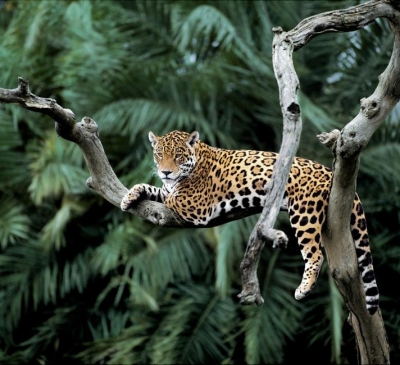
The jaguar – the third largest of the big cats, after the tiger and lion. They look quite like leopards but have bulkier bodies and the rosettes on their coats are larger, with a spot at the centre. Unlike most cats, jaguars do not avoid water and will catch fish, turtles and caimans, as well as deer, capybara and other land animals.
The name “jaguar” is a corruption of the Brazilian Tupi-Guarani people’s name for this big cat. In their language, “yaguara” means “beast”. The largest cat in the Americas, the jaguar is the third largest feline in the world, after the tiger and lion.
The jaguar is an essentially solitary animal. It hunts alone, wandering through the forest across its territory and ambushing prey opportunistically. The bite of the jaguar is unusually powerful even among large felines, and it is capable of perforating the hides of large reptiles and the shells of turtles. Unusually among big cats, it often attacks the head of its prey directly, relying upon its powerful jaws to penetrate the skull and bite into the brain.
Jaguars are adept swimmers and will readily take to the water in pursuit of their prey. They have been spotted crossing the Tambopata River, and will occasionally take down small caiman.
In the wild, jaguars tend to live for between 11 and 15 years, and can live up for to 25 years in captivity. Jaguars are almost always sighted alone. As solitary hunters, they only come together to breed. When seeking a mate, jaguars tend to roam over vast areas of forest, far beyond their normal hunting range. It is believed that jaguars will breed throughout the year, in wet season or dry. Receptive females mark their territory, in addition to becoming increasingly vocal, when seeking a mate. After breeding, the male and female separate, leaving the female to raise her cubs alone. In common with the tiger, female jaguars will not tolerate the presence of any male after the birth of their cubs, given the high risk of infant cannibalism prevalent among these two species.
Tambopata National Reserve is an ideal place to spot the jaguar (Panthera onca) because its forest and wetland systems are home to many of the species that this big cat preys upon, including capybaras, peccaries and tapirs.
Credit : Tambopatalodge.com
Picture Credit : Google




